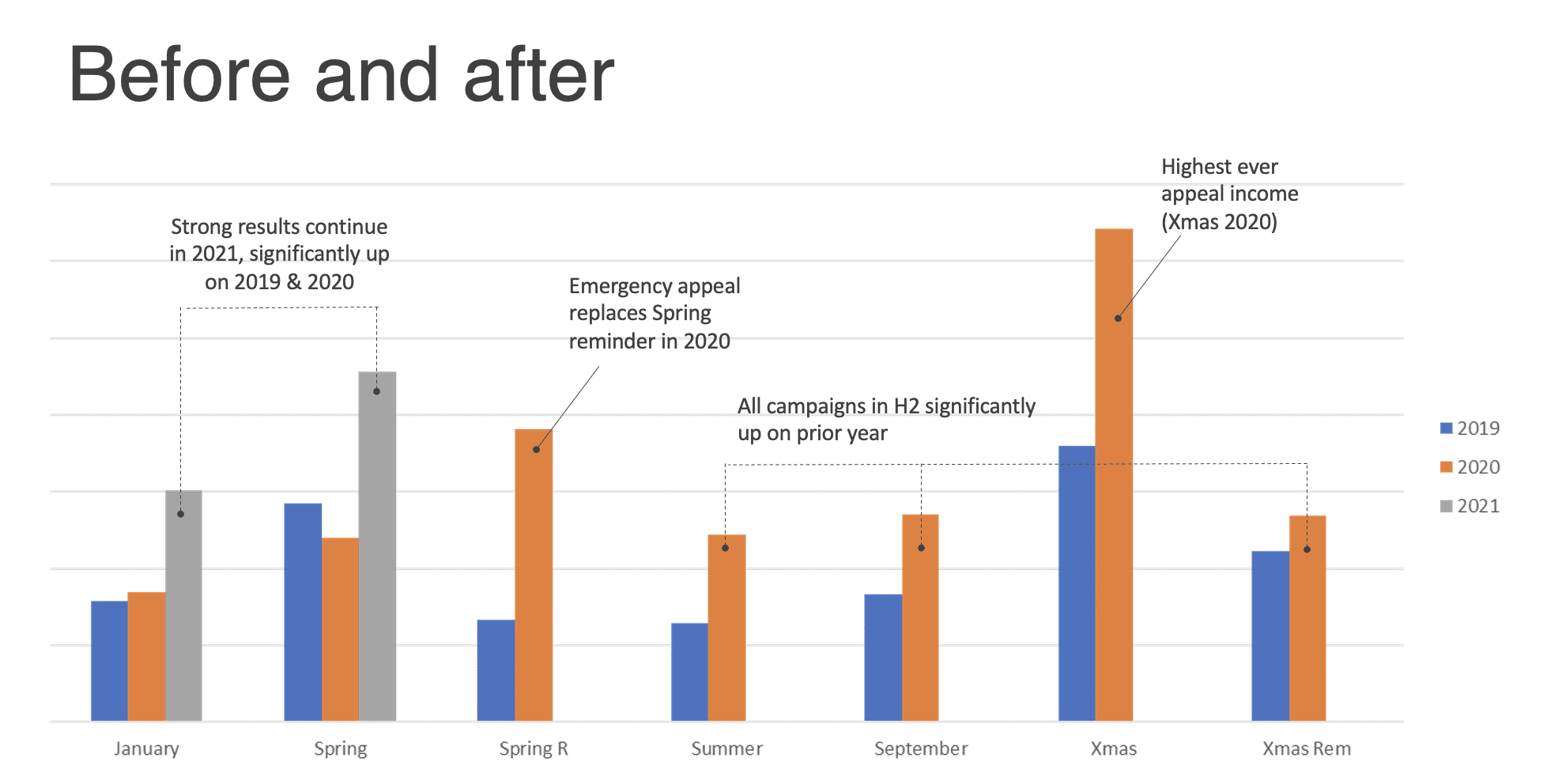What are the long-term effects of coronavirus on fundraising?
After speaking to a diverse group of donors, Mark Phillips explores the long-term impact of the pandemic on the fundraising sector and gives advice as you plan for 2022 and beyond.
- Written by
- Mark Phillips
- Added
- November 25, 2021

Month after month for well over a decade, at Bluefrog we have been speaking to donors about their attitudes to giving to charity.
That’s around 100 studies, across many different themes. We’ve learned what people think about regular giving, mid-value gifts, safeguarding, legacies, alumni giving and why they lapse. All alongside discovering a host of other insights about why donors behave in the way they do.
But since March 2020, we have concentrated on uncovering exactly how the pandemic has impacted on their giving (and helping) behaviours. We’ve spoken to in excess of 300 people from different genders, faiths, ages, races and economic backgrounds.
With the vaccine booster campaign well underway and few legal restrictions impacting on our daily lives (in the UK), we have now turned our attention to trying to unpick what the lasting impact of the pandemic will have on giving to charity and making some suggestions about what this means for fundraisers as they plan for 2022 and beyond.
Public generosity is still very high
By comparing the results of pre- and post-pandemic appeals, we can see that public generosity rocketed way above the pre-pandemic normal.
Looking at income raised by direct mail (DM) appeals at two key points in the annual cycle – Christmas 2019 versus Christmas 2020 and Summer 2020 versus Summer 2021 – we have seen that on average, income is up by 63 per cent (across a range of clients).
That’s a huge increase. It’s unlike anything I have seen before in my career. And when you look more deeply, you can see that this boost in generosity doesn’t seem to be a flash in the pan. Take a look at the chart below which shows what we have seen for one client over seven different appeals:

What’s most exciting is illustrated by the grey columns. These represent appeals mailed this year – in 2021. They continue to show growth. One recent appeal is over 75 per cent above target and this is far from unusual.
So why are donors being so generous? Here are five points that donors have raised with us that help explain their behaviour, along with a few suggestions about how you can adapt your appeals to answer donor needs.
1. Many people made significant savings over the course of the pandemic
Being stuck at home meant one thing for many people – they stopped spending money and started saving. By November 2020, the Bank of England estimated that UK household savings had grown by £125 billion. This had further increased to £190 billion by June 2021.
In other words, over the course of the first part of the pandemic, the total sum given to charity in an average year was being deposited into saving accounts every few weeks. A significant number of people had plenty of extra to give or spend and many of the people we spoke to said that they would give more to charity as a result. These three quotes (from three different donors) sum up much of what we heard:
‘People my age – because I live in a retirement complex – they are saying “I don’t know what to do with my money, I’ve saved so much’.
‘As far as I know my income is not going to be affected, whereas those who have lost their jobs it’s different. I probably would respond more to appeals now.’
‘Being retired and having enough income with the pension it’s not affected us in that way. Obviously, we’re not seeing family… We’ve been healthy and doing what we’re told… it comes up on Facebook, (charities saying) “during these times we are having a hard time”, and they do say it on the television as well. I don’t understand if people are paying monthly why they would stop because of the pandemic.’
2. People don’t like uncertainty
Donors have always been more motivated to act when they are presented with a vision (ideally in the form of a predicted outcome). The more achievable this is, the better. We found that this became more pronounced during the pandemic because the uncertainty we all experienced was so unnerving.
As government incompetence became more apparent, people looked elsewhere for certainty. For many, this was to the National Health Service (NHS) and charities. Many donors worried about one thing – how could we beat the virus? And they needed to know that there were trusted partners out there to help them.
Stuck at home there wasn’t much that people could do to join the fight apart from give. And even now, though many things appear relatively normal, the threat of the virus re-emerging in some way is still a powerful driver for people to maintain their support for the organisations they trust to take care of the problems that worry them. We heard many comments like these over and over again:
‘It will be like the flu, and they will update the vaccination. Or maybe they won’t? I think we will have to live with this now.’
‘There will be new variants.’
‘I’m so sick of it. The virus will be around. Probably forever.’
They key takeaway from this is that charities need to be extra clear about what they need to do and what they plan to achieve. As I’ve said many times, three words sum up what we should be doing with our communications – solve, don’t sell.
3. The survival instinct works in a variety of ways
We can rearrange and window dress the upper levels of Maslow’s Hierarchy as much as want, but the foundation level stays same – people need to feel safe.
At times of crisis, survival instincts will overwhelm many of us. This can drive behaviour such as the panic buying of toilet roll or petrol and hoarding of essentials.
The fact is that people do what they need to get by, particularly when they can’t trust their leaders. But this goes far beyond material goods. People also want to be seen as a valuable member of society.
Giving became a way for many donors to demonstrate this. Social media accounts were filled with posts about the causes that were seen to be most important, hashtags became ever more common, and windows were adorned with posters. Many of us shared selfies with the stickers we received once we had our first jab. These devices were also important in our fundraising appeals as well. Including badges and stickers drove an uplift in response rate and average gift as the desire to show who you are and what you believe in grew in importance.
This need to be seen to be on the side of good is still very powerful. Anything you can do to give your supporters the chance to feel part of your community - and show off about it - should be part of your 2022 fundraising strategy.
4. People only have a certain amount of emotional bandwidth
As human beings, we only have so much emotional bandwidth that can be allocated to dealing with problems, stresses, or difficulties. Too much can be overwhelming.
As a result, we heard many examples of how the pandemic caused many of us to lose perspective. On a macro level, this could be seen with the growth of conspiracy theories. But it also occurred in many personal interactions as well. We heard reports of people experiencing upsetting misrepresentations of what they were saying or being on the wrong end of an over-reaction to simple mistakes. It may have come in waves, but the emotional temperature has been much higher throughout the months of the pandemic.
We need to remember that we all need permission to take break from these stresses and look away. This specific need is very important for fundraisers to appreciate.
Giving is a way for donors to allow charities to take charge of the things that they care about. Many of us have been psychologically impacted by the pandemic. Giving allows us to make sure the work we valued would continue whilst we step back and take a break. When constructing your appeals, please give consideration to how you might extend this offer to your supporters.
5. People enjoyed being part of the challenge
Reciprocal altruism is adaptive. We are social beings and, as a result, are wired to help other members of our group. In the early years of society, isolation would usually mean death. That’s something most of us would want to avoid.
Over the course of the pandemic, we have seen the power of reciprocal altruism get dialled up. As a result, physically helping others became a much higher status activity than back in 2019. Anything to which society attaches status becomes very attractive. And that definitely included beating coronavirus.
It became a national challenge that we all wanted to be part of. But it wasn’t just the virus that we wanted to fight. As we spent more time at home, we consumed more news and spent more time on social media. The result was that we learned more about the virus (both good and bad) and how we were combatting it, but we also had new areas of concern brought to our collective attention. It might have been children going without food, racial injustice or worries about how a local hospice might be struggling with higher costs and lower income. And many donors started to support new causes as a result.
But it also refocussed our thoughts on the causes that we have always held dear. For example, if a donor is concerned about global poverty, they made sure their support for that work did not cease – even when there were greater demands on their pockets from closer to home.
And now, when we are well into our second year of living with the virus, we see a level of nostalgia about the collective effort that characterised the first few months of the pandemic. People speak with a level of pride about how we were ‘all in it together’ and ‘focused on what really matters, helping each other’.
We can create more effective appeals by considering how we can re-create that sense of tackling a challenge when we communicate with donors. Whether it is by highlighting a specific problem or even by giving supporters the chance to refill financial coffers depleted by the initial response to coronavirus. Donors want to feel their efforts will make a difference (as they always have done), but more importantly, the pandemic helped us realise that there was more purpose to our giving than we had previously realised. Donors want more of that.
Refocus your communications to answer the needs of your donors
In short, it’s not time to forget the pandemic and get back to normal (whatever that might mean). Many donors are still concerned about the long-term impact of the virus and still know their help is needed. Coronavirus is still a key lens through which donors are making their own personal philanthropic decisions. Whether your appeals are doing well or are struggling, you might find it useful to try some of these tips. They have worked incredibly well for our clients.
Editor’s note: this article first appeared on Mark’s blog here. We would like to thank Mark and Bluefrog Fundraising for allowing us to reproduce this piece on SOFII.

















